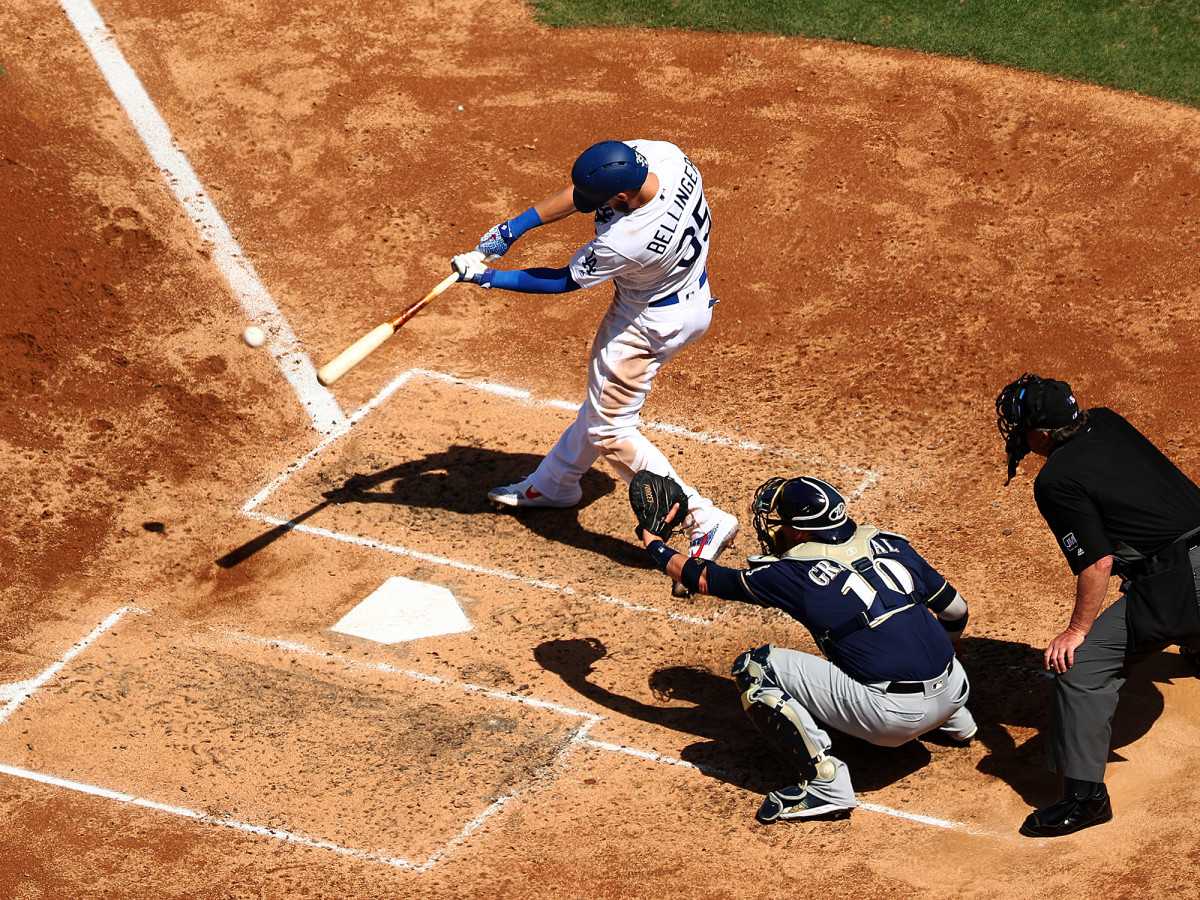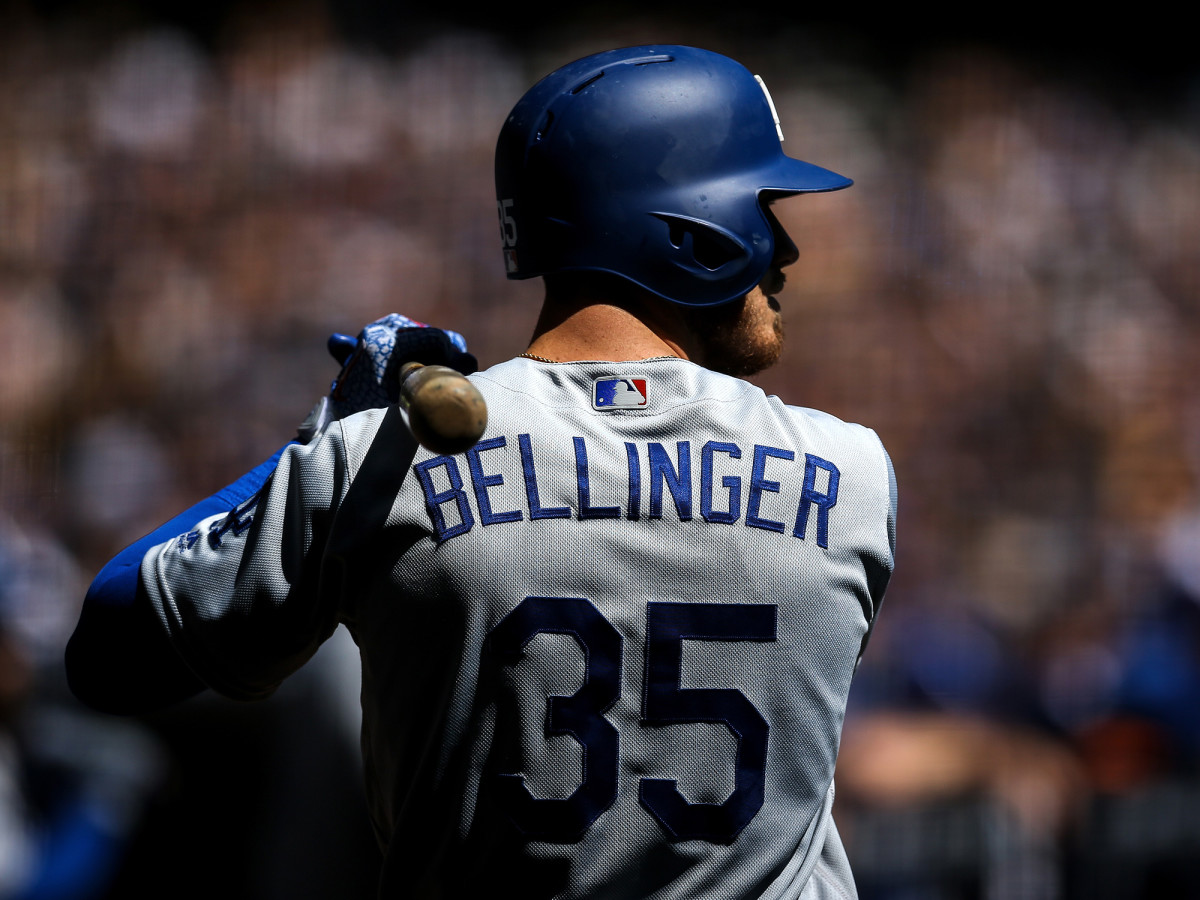Inside Cody Bellinger's Early Run at Hitting .400

In the 78 years since Ted Williams became the most recent player to hit .400 or better, scores of men have come close to the fabled number only to fall short. Tony Gwynn was closest to the summit when he hit .394 over the strike-shortened 1994 season. George Brett got as high as .390 in 1980. Rod Carew posted a .388 batting average three years earlier; so did Williams in ’57, at the age of 38 (!).
But it’s been quite some time since anyone got within striking distance. Joe Mauer’s .365 in 2009 is the top figure of the last decade. The high-water mark of the millennium, meanwhile, is .372, with three different hitters—Nomar Garciaparra, Todd Helton (both 2000) and Ichiro Suzuki (‘04)—finishing there but no better. No one’s cracked .380 since Gwynn got within a few hits of the mountaintop in ‘94, and he, Brett and Carew are the only non-Williams hitters since World War II to do even that. “Why no one will hit .400 ever again,” was how ESPN’s Sam Miller titled a piece back in February 2018, breaking down why the figure was now all but impossible to attain. “I’m becoming increasingly convinced that .400 has become an unbreakable threshold,” Miller wrote, “that .400 has quietly moved from baseball’s living history to a relic of its distant past.”
Stop @Cody_Bellinger? Wish Wish. pic.twitter.com/t7xxX3GJEY
— Los Angeles Dodgers (@Dodgers) May 19, 2019
Miller is likely right, but so far this season, one man is trying his best to turn back the clock. Following Tuesday night’s game against the Rays, Dodgers outfielder Cody Bellinger is now toting a .404 batting average (to go with a gaudy .487 on-base percentage and Bonds-ian .783 slugging percentage) across 166 at-bats, or roughly a quarter of the season. He’s the first major leaguer to hit .400 this late into the year since David Wright in 2012, who started May 25 with a .405 average (and then hit .273 the rest of the way to finish at .306). Perhaps most impressively, the player mounting one of the most serious challenges to Williams in decades is probably the last one you would have expected—one who made his bones with a big, lofting swing that piled up home runs and strikeouts.
When Bellinger made his debut in 2017, he quickly showed off incredible raw power with 39 homers and iffy plate discipline with 146 strikeouts. Things didn’t improve in 2018, as his overall production slipped to a .260 average, 25 homers, and a 23.9% strikeout rate. Armed with an uppercut hack that perfectly fit the game’s new emphasis on launch angle, fly balls and home runs, Bellinger was built for power, not contact. Swinging and missing was an inextricable part of his game.
Or at least, it was. This year, Bellinger has displayed a newfound patience at the plate, improving his numbers across the board.
| Strikeout Rate | Walk Rate | Contact Rate | Swinging Strike Rate |
|---|---|---|---|---|
2018 | 23.9% | 10.9% | 72.4% | 12.3% |
2019 | 14.4% | 13.9% | 80.6% | 8.3% |
That 9.5% drop in strikeout rate from last season to this one is tied for second best with Boston’s Rafael Devers among qualified hitters. Likewise, that improvement in swinging-strike rate is fifth best, and the change in contact rate is the fourth highest. All those things go a long way toward making .400 a semi-realistic goal.
There’s more to it than cutting down the whiffs, though. Bellinger’s ground-ball rate has plummeted, going from 40.0% last year to 29.9; getting rid of the balls most likely to turn into outs will do wonders for a high batting average. Consequently, he’s hitting more line drives, upping that rate from 19.9% in 2018 to 32.8—second best in baseball, a fraction behind Freddie Freeman. His infield fly-ball rate is a career-low 3.9%. And while he’s actually hitting fewer fly balls, more of them are turning into homers, at a rate of 33.3%, the fifth highest in the game.
None of that makes a difference, though, if you don’t hit the ball hard when you do make contact, and Bellinger is tops at that too. His average exit velocity of 92.9 mph ranks 13th among all hitters with 50 or more batted balls. His hard-hit percentage of 52.2 is good for 14th, and his percentage of Barrels—15.7—sits 27th in the league. Others like Joey Gallo and Gary Sanchez have him roundly beat in those categories, but they don’t marry that power with Bellinger’s plate discipline or batted-ball consistency.

Nor do they have what’s been Bellinger’s secret weapon in the chase for .400: BABIP. His .403 batting average on balls in play is the third highest in the league, trailing the Rockies’ David Dahl (.432) and the Cubs’ Javy Baez (.412). Normally, you’d expect a figure that high to drop substantially over the course of a season, especially when it’s so far above the league average (currently .291). But Bellinger’s BABIP isn’t all fueled by luck. As already noted, he hits the ball hard and puts it in the air, both of which are excellent ways to maintain a high BABIP figure. On top of that, he’s legged out a high number of infield hits: His 12.2% rate in that category is 19th in the league. It’s no fluke, either, as Bellinger ranks among the league’s fastest players, with a Sprint Speed of 29.2 seconds—good for 23rd in baseball.
If you add all that up, you’ll see that even the advanced stats think Bellinger has earned his high batting average. Per Statcast, his expected batting average—derived from a combination of exit velocity, launch angle, speed and other factors—is at .394. Whether Bellinger can keep all those elements going at peak levels will be the deciding factor in just how possible .400 is, but the point here is that, if you look under the hood, you’ll see that the engine is in pristine condition. This isn’t built on air.
In writing about the challenge of hitting .400, Miller noted that the ideal candidate would virtually never strike out, hit a ton of homers, and maintain a high BABIP. That’s a hard combo to find: Power hitters invariably strike out a lot, and high-contact/low-strikeout guys often don’t hit for much power. But in Bellinger, this mythical player actually exists—or at least has for the last two months. The trick will be the BABIP, which even with all of Bellinger’s thump will likely fluctuate and dip, and also avoiding prolonged slumps. Though “slump” is relative. All it took to stymie Brett’s dreams of .400 in 1980, for example, was a stretch from Sept. 5—the last day he was at or above .400—through the end of the year in which he hit .323.

Regardless of whether or not Bellinger can succeed where Brett, Gwynn, Carew and several others failed, what he’s doing is still outlier enough in a game that continues to move further and further away from base hits. The league as a whole is hitting a meager .245 on the year, which would be the worst mark over a full season since 1907. Only five years since 1900 have seen lower batting averages; things were just as bleak in 2018, when major league hitters posted a collective .248 mark. The rise of velocity and the attendant increase in strikeouts has made putting bat on ball harder than ever: 2019’s 76.1% contact rate is the lowest mark on record since 2002 and would represent a fifth straight year of decline. Concurrently, batting average on balls in play is also at a 17-year low, even as batters are crushing the ball better than ever: The league-wide–hard-hit rate is 37.4%, topping last year’s record-setting 35.3.
Combined with the preponderance of defensive shifts and a propensity among hitters to sell out for power, it’s easy to see why .400 is more endangered than ever before. Baseball hasn’t seen a harder hitting environment since the 1960s; that makes it awfully hard to envision someone putting together the requisite hot streaks and lucky patches necessary to collect four hits every 10 at-bats over and over again.
All of which is to say the odds are against Bellinger. But that’s not to say that what he faces is impossible. Getting to .400 is unlikely at best, as hundreds upon hundreds of hitters have learned over the last seven decades. In Bellinger, though, all the pieces are there for, at the very least, a serious run at one of the game’s most elusive records.
